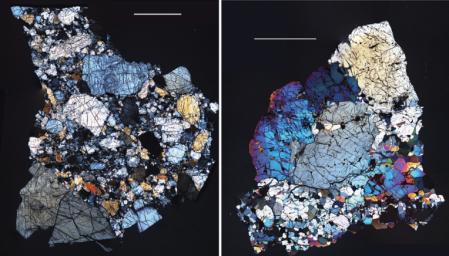
|
Rocks from Vesta – Part 3: Diogenites
- Click the image above for a larger view
- Full-Res JPEG (1000 x 571) (141.9 kB)
- Full-Res TIFF (1000 x 571) (1.7 MB)
Caption:
The HED (howardite, eucrite and diogenite) meteorites are a large group of meteorites believed to originate from Vesta, a hypothesis that is consistent with current Dawn observations. The diogenites originated deep within the crust of Vesta and resemble rocks, both in texture and composition, which we find in the lower crust of the Earth. The QUE 99050 (left) and GRA 98108 (right) diogenites, pictured here, were recovered in Antarctica. These images are of thin slices of the meteorites as viewed through a polarizing microscope. The white bars in the images, each 2 millimeters long, indicate the scale. When polarized light passes through thin slices of rock, different minerals have different colors. QUE 99050 (left) consists of large gray and yellow crystals of pyroxene (magnesium-iron silicate) and is a subgroup of diogenite called "orthopyroxenitic diogenite" (orthopyroxenite is the name of a rock composed primarily of the mineral orthopyroxene). GRA 98108 (right) has a more mafic (i.e. magnesium and iron rich) mineralogy, consisting of roughly equal portions of pyroxene and the much brighter colored olivine, a silica-poor iron magnesium-iron silicate. This olivine-rich "harzburgitic diogenite" (harzburgite is the name given to a rock composed of a mixture of the minerals orthopyroxene and olivine) is thought to represent the most deep-seated rocks from Vesta that we have in the meteorite collection. Diogenites like these comprise some fraction of Vesta's lower crust, and their compositions can be compared with observations from various instruments aboard Dawn. They can be compared with the VIR (Visible and Infrared Imaging Spectrometer) spectra to determine mineralogy and with the GRaND (Gamma Ray and Neutron Detector) observations to calibrate and interpret the GRaND instrument's responses. Similar rocks have likely been excavated by large impacts, such as the one that formed the Rheasilvia basin at the south pole of Vesta.
Background Info:
The Dawn mission to Vesta and Ceres is managed by NASA's Jet Propulsion Laboratory, a division of the California Institute of Technology in Pasadena, for NASA's Science Mission Directorate, Washington D.C. UCLA is responsible for overall Dawn mission science. Dawn's VIR was provided by ASI, the Italian Space Agency and is managed by INAF, Italy's National Institute for Astrophysics, in collaboration with Selex Galileo, where it was built.
More information about Dawn is online at http://www.nasa.gov/dawn and http://dawn.jpl.nasa.gov .
Cataloging Keywords:
| Name | Value | Additional Values |
|---|---|---|
| Target | 4 Vesta | |
| System | Main Belt | |
| Target Type | Asteroid | |
| Mission | Dawn | |
| Instrument Host | Dawn | |
| Host Type | Orbiter | |
| Instrument | ||
| Detector | ||
| Extra Keywords | Color, Impact, Infrared | |
| Acquisition Date | ||
| Release Date | 2011-12-04 | |
| Date in Caption | ||
| Image Credit | NASA/JPL-Caltech/Hap McSween (University of Tennessee), and Andrew Beck and Tim McCoy (Smithsonian Institution) | |
| Source | photojournal.jpl.nasa.gov/catalog/PIA15138 | |
| Identifier | PIA15138 | |
